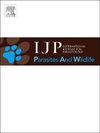Identification of zoonotic pathogens in zoo animals in the Republic of Korea
IF 2
3区 医学
Q3 ECOLOGY
International Journal for Parasitology-Parasites and Wildlife
Pub Date : 2025-04-04
DOI:10.1016/j.ijppaw.2025.101067
引用次数: 0
Abstract
Zoo animals may harbor various zoonotic pathogens and may pose a potential risk to humans through close contact. Nevertheless, epidemiological data on zoonotic diseases are scarce. Here, we conducted an epidemiological investigation and genetic characterization of Coxiella burnetii, Cryptosporidium species, Enterocytozoon bieneusi, and Giardia duodenalis in zoo animals in the Republic of Korea (ROK) and evaluated their zoonotic potential. A total of 261 fecal samples were collected from 27 animal species at one zoo between July 2022 and December 2023. Out of the four pathogens tested, one (0.4 %), twelve (4.5 %), and one (0.4 %) animals were found positive for C. burnetii, E. bieneusi, and G. duodenalis, respectively. Cryptosporidium species were not detected in zoo animals. Sequence analysis of C. burnetii based on the IS1111 gene revealed that one sequence obtained from a black goat (Capra hircus) exhibited 100 % homology with those reported from a rodent in the ROK. A zoonotic assemblage B (n = 1) of G. duodenalis was identified in Patagonian mara (Dolichotis patagonum). Of the 12 E. bieneusi-positive samples, eleven novel genotypes (KRZB1−4 and KRZS2−8) were identified in four Asian black bears (Ursus thibetanus ussuricus) and eight squirrel monkeys (Saimiri sciureus). Phylogenetically, ten novel genotypes belonged to group 1 with zoonotic potential, and one novel genotype, KRZB4, was assigned to group 10. This study showed that C. burnetii, E. bieneusi, and G. duodenalis infections were identified in zoo animals in the ROK. Our findings highlight the need for ongoing monitoring and effective strategies to prevent and control these zoonotic pathogens.

韩国动物园动物中人畜共患病病原体的鉴定
动物园动物可能携带各种人畜共患病病原体,并可能通过密切接触对人类构成潜在风险。然而,关于人畜共患疾病的流行病学数据很少。本文对韩国动物园动物中的伯氏柯谢氏菌、隐孢子虫、宾氏肠胞虫和十二指肠贾第鞭毛虫进行了流行病学调查和遗传特征分析,并对它们的人畜共患潜力进行了评价。在2022年7月至2023年12月期间,在一家动物园共收集了27种动物的261份粪便样本。在检测的四种病原体中,分别有1只(0.4%)、12只(4.5%)和1只(0.4%)动物对伯氏梭菌、比氏梭菌和十二指肠梭菌呈阳性反应。动物园动物未检出隐孢子虫。基于IS1111基因的伯氏疏螺旋体序列分析显示,从黑山羊(Capra hircus)中获得的一个序列与韩国啮齿动物报道的序列同源性为100%。在巴塔哥尼亚(Patagonian) mara (Dolichotis patagonum)中鉴定出一个十二指肠棘球绦虫(G. duodenalis)人畜共患组合B (n = 1)。在12份阳性样本中,从4只亚洲黑熊(Ursus thibetanus ussuricus)和8只松鼠猴(Saimiri sciureus)中鉴定出11种新的KRZB1−4和KRZS2−8基因型。在系统发育上,10个新基因型属于具有人畜共患潜力的第1组,1个新基因型KRZB4属于第10组。本研究表明,在韩国动物园动物中发现了伯氏梭菌、比氏梭菌和十二指肠梭菌感染。我们的研究结果强调需要持续监测和有效的策略来预防和控制这些人畜共患病原体。
本文章由计算机程序翻译,如有差异,请以英文原文为准。
求助全文
约1分钟内获得全文
求助全文
来源期刊

International Journal for Parasitology-Parasites and Wildlife
Medicine-Infectious Diseases
CiteScore
3.80
自引率
5.60%
发文量
113
审稿时长
45 days
期刊介绍:
The International Journal for Parasitology: Parasites and Wildlife (IJP-PAW) publishes the results of original research on parasites of all wildlife, invertebrate and vertebrate. This includes free-ranging, wild populations, as well as captive wildlife, semi-domesticated species (e.g. reindeer) and farmed populations of recently domesticated or wild-captured species (e.g. cultured fishes). Articles on all aspects of wildlife parasitology are welcomed including taxonomy, biodiversity and distribution, ecology and epidemiology, population biology and host-parasite relationships. The impact of parasites on the health and conservation of wildlife is seen as an important area covered by the journal especially the potential role of environmental factors, for example climate. Also important to the journal is ''one health'' and the nature of interactions between wildlife, people and domestic animals, including disease emergence and zoonoses.
 求助内容:
求助内容: 应助结果提醒方式:
应助结果提醒方式:


